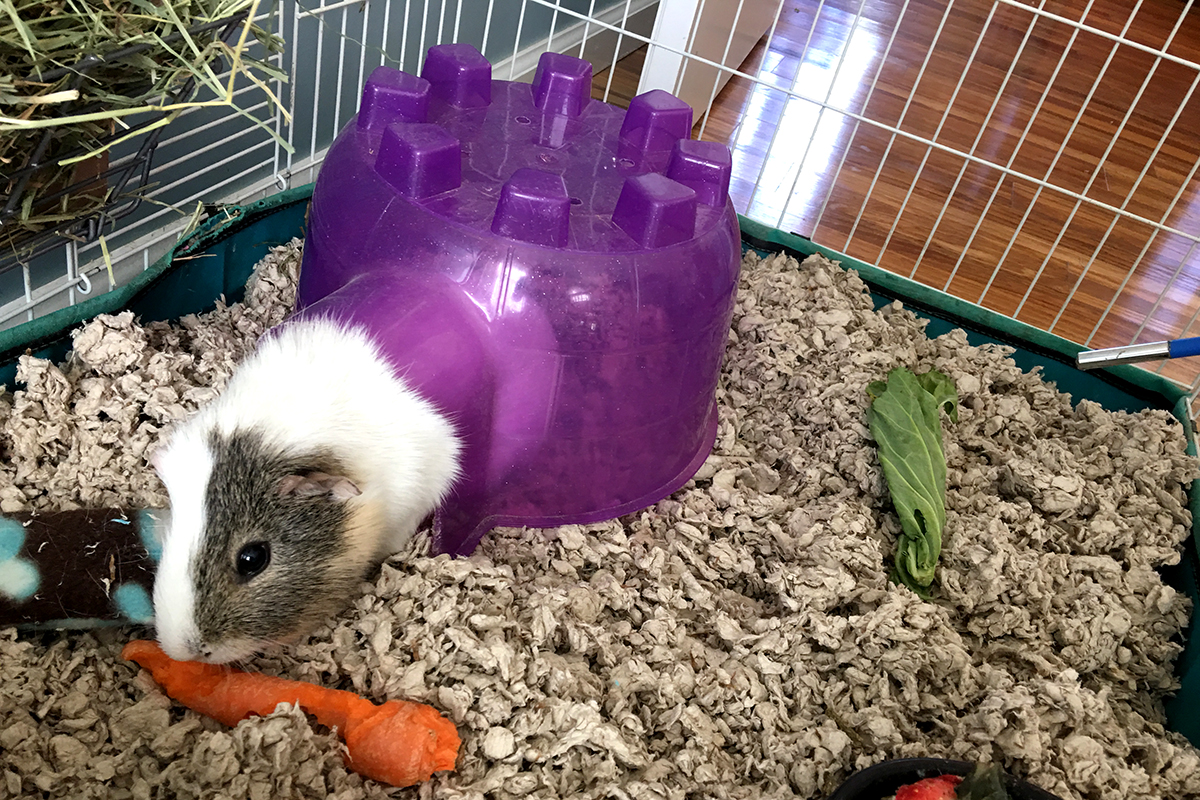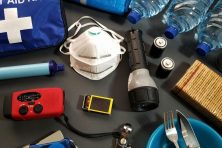Save On Pet Guinea Pig Supplies With DIY Know-How and Smart Shopping

I’ve had two guinea pigs, Chocolate and Vanilla, for almost five years, and they make wonderful pets. They’re low- maintenance and cute as anything.
But like any pet, a guinea pig has needs that can dent your bank account. Through trial and error, I figured out what to buy and what to skip.
Habitat
The first thing you need when you adopt a guinea pig is a cage. But not all small pet cages are suited for guinea pigs. Guinea pigs cannot live in a wire-bottom cage like rabbits can. They must have some kind of flooring to protect their feet, which are small and sensitive.
I found the cages at pet stores woefully lacking. They were too expensive and too small. The Humane Society of the United States recommends housing a maximum of two guinea pigs in a cage that’s at least 7.5 square feet. Most cages advertised for guinea pigs are much smaller.
I purchased an uncovered MidWest guinea pig cage for about $35 on Amazon. Not only was it cheaper than pet-store cages, it was roomy enough for my two guinea pigs to claim their own territory and get some exercise. (Males, especially, need room to avoid each other when they’re grouchy.)
Lots of guinea pig owners prefer to build their own cage. The supplies are available at most big-box and office-supply stores and allow owners to customize their cages at a low cost. Alexandria’s Animals on YouTube has a video on how to build a C & C (cubes and corrugated plastic) cage.
Bedding
Bedding is where I spend most of my guinea-pig dollars because we clean our cage at least once a week.
The easiest bedding option is natural paper bedding. You can buy it in pet stores, big-box stores and even some grocery stores.
However, I found that the cheapest place to get bedding is Amazon. I search for guinea-pig bedding, then I scroll through the list to see which one is the cheapest per liter. Generally, I can get a 60L package of paper bedding for approximately $15. Sometimes I score one on sale for about $13. One package of bedding lasts almost a week in our house.
The trick is not to become loyal to a particular kind. I’ve even ordered confetti-colored paper bedding because it was the cheapest choice.
An even cheaper option, in the long run, is to use fleece. Lots of guinea-pig owners prefer to use fleece to line their cages because it’s reusable and they feel it’s more comfortable for their guinea pigs.
However, you have to have the right kind of fleece, which wicks urine down to an absorbent layer underneath. Look for 100% polyester anti-pill fleece. Then prepare the fleece by washing and drying it three to five times in hot water with detergent, without fabric softener or dryer sheets. Washing the fleece over and over removes the protective barrier from the fleece and allows liquids to pass through.
Once the fleece is prepared, place it in the cage on top of an absorbent layer, like paper bedding, puppy pads or newspaper. Jessica’s Nerd Life has a YouTube video on how to prepare fleece for guinea pig cages.
I’ll be honest; I tried the fleece method and I couldn’t hack it. I didn’t like sweeping up poop and hay every day. Plus, you have to have at least two prepared fleeces: one to use and one to wash. On top of that, I couldn’t get it to work properly. The smell was awful. I decided to stick with paper bedding.
You may be thinking that newspaper would be a cheap alternative to paper bedding, but I don’t recommend it. Newspaper tends to soak up urine, leaving your poor piggy in sopping wet, smelly bedding after only a day.
Please do not use pine or cedar shavings for guinea-pig bedding. Although it’s still sold in stores, the oil and resin can be harmful to small pets. The aromatic oils from pine and cedar can irritate a guinea pig’s skin, eyes and respiratory tract.
Food

Guinea pigs need hay, preferably Timothy hay. Not only do they get nutrition from hay, it keeps their teeth from growing too long. Guinea pigs, like rabbits, have teeth that will continue to grow to unhealthy lengths if they don’t have something hard to chew on. Hay takes a lot of chewing.
Guinea pigs also need pellet food, preferably made from Timothy hay. Pellets that have alfalfa hay as a base are high in calcium, which may lead to bladder stones.
I buy pellet food and Timothy hay from Amazon. Again, I’m not loyal to a brand, so I’m able to buy the cheapest options. I generally buy a five-pound bag of Kaytee pellet food for about $6. It lasts for several months.
Don’t be tempted to buy guinea-pig pellet food with extras — those colorful nuggets of non-nutritious food that’s added to the pellets. According to VetBabble, it’s like adding candy to their healthy food.
Guinea pigs must also have fresh produce. They can’t produce vitamin C, so they need to get it from their food. I feed our guinea pigs carrots, kale and, for a treat, strawberries. I occasionally give them a bit of apple.
The good news is that they’re not super picky. Check your grocery store for a produce clearance section. My store has a shelf with bruised, broken and spotted fruit and vegetables that I can buy at about a third of the full price. My little guys don’t care if their carrots are starting to brown. (But I would never feed them rotten food.)
Chews
As mentioned above, guinea pigs need to chew on stuff to keep their teeth a healthy length. Stores sell all kinds of wooden blocks and hay cubes, but they’re expensive and unnecessary.
Guinea pigs can chew on cardboard, which is probably as plentiful in your house as it is in mine. Remember all my Amazon orders? I use the boxes to build “additions” to my guinea pigs’ cage. They usually chew on the cardboard flaps.
You can also give your guinea pig a paper towel or toilet-paper tube to chew on. Try shoving lettuce or other foods inside to give your guinea pig a boredom buster.
What Not to Buy
There are a lot of products out there for guinea pigs that are a waste of money. Here are things you don’t need to buy.
Litter. Guinea pigs are nearly impossible to litter train. Don’t bother.
Toys. Guinea pigs don’t play with toys. They’re happy with a cardboard box or tube. You can also create tunnels and mazes from cardboard to give them some exercise and fun.
Clear, plastic balls. Guinea pigs are not hamsters. They will not run around the house in a big, clear ball. They will just sit and wonder what’s happening.
Fancy houses. Guinea pigs like to have a cover over their heads, but they don’t need anything fancy. A plastic igloo or cardboard box works just fine.
Pillows. You might see videos of guinea pigs sleeping with their heads on pillows. It’s super cute, so I bought two on Etsy. My guinea pigs completely ignore them.
Nancy Basile is a freelance writer who didn’t expect to fall in love with her two guinea pigs, Chocolate and Vanilla. Follow her on Instagram @mediamedusa.












